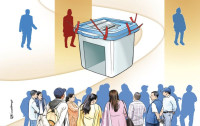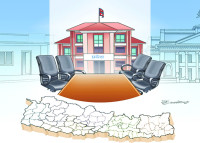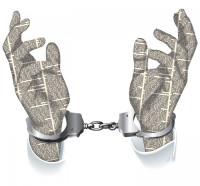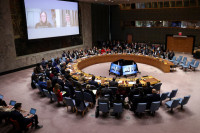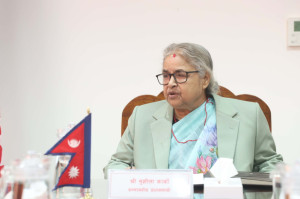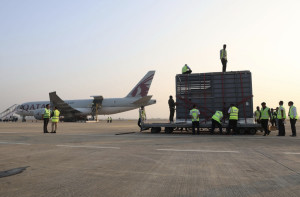Columns
Nepal’s first sovereign credit rating
Fitch rating should encourage the government to create a favourable investment climate.
Nischal Dhungel
A few years ago, the government of Nepal attempted to obtain a sovereign credit rating. In simple terms, a sovereign credit rating measures a country’s ability to repay its debts. On November 21, 2024, Nepal finally received a rating from Fitch, one of three American credit rating agencies (Standard & Poor's and Moody's). The ratings range from AAA to D, with AAA being the highest and D the lowest.
Fitch assigned a rating of "BB-" to Nepal, placing the country among the developing economies under a speculative-grade rating similar to Bangladesh (export-driven growth economy), also referred to as "junk status." This means that Nepal carries a higher risk profile for investors compared to countries with investment-grade ratings. India has a 'BBB-' investment-grade rating and widely benefits from a more diversified economy and a larger domestic market. However, Pakistan has a 'CCC+' rating because of the prolonged economic and political instability.
FDI status
Given the recent Fitch rating, it is essential to look at how Nepal’s foreign direct investment (FDI) is faring. The trend has shown some volatility in recent years. In 2019, Nepal received approximately Rs21.3 billion ($190 million); in 2020, FDI decreased by 31.76 percent to Rs15.6 billion ($130 million). As post-pandemic recovery gained traction, the FDI rebounded in 2021, increasing by 55.04 percent to Rs23.6 billion ($200 million). In 2022, inflows decreased by 66.8 percent to Rs8.1 billion ($65 million), or 0.16 percent of GDP.
In the first four months of the current fiscal year (FY) 2024-25 (July 16, 2024, to November 15, 2024), Nepal received FDI commitments of Rs17.64 billion ($130.5 million) across 163 projects, where the commitments were mainly concentrated on small-scale projects, followed by medium- and large-scale projects. Sector-wise, tourism led with 66 percent, followed by services (23 percent) and manufacturing (7 percent). The actual net FDI inflow, amounting to just Rs4.81 billion by mid-October, is like the last FY, where only 13.57 percent (Rs8.40 billion) of the committed Rs61.90 billion was realised. In FY 2021, the actual net FDI inflow represented approximately 34.27 percent (Rs18.56 billion) of the committed amount (Rs54.15 billion). Additionally, the automatic route for FDI approvals in the current FY facilitated 109 projects, with total commitments of Rs1.6 billion ($12.04 million), where the majority of investments were in information and communication technology (ICT), 70 percent, followed by manufacturing and tourism (11 percent each).
However, FDI in Nepal remains a critical challenge because such an investment (net flow) as a share of GDP is less than 1 percent, and there is a big gap between commitments and actual disbursement. Burdensome procedures on profit repatriation and other regulations on external transactions have historically constrained FDI inflows. At present, FDI priority sectors are energy, infrastructure and IT-based industries, but the FDI inflows are unsatisfactory given the sectors’ potential. Regulatory hurdles, land use and remittance dependence represent missed opportunities to attract enough FDI to the country.
Debt status
Nepal’s public debt reduced from 42.9 percent of GDP in FY 2023 to 42.7 percent in FY 2024 because of a slight reduction in the fiscal deficit. This is a positive development, as Nepal’s public debt remains lower than the median for other Fitch 'BB' rated countries, which stands at 55 percent. The public debt comprises 49 percent domestic debt, mostly Treasury Bills and development bonds, and 51 percent external concessional loans with low interest rates and extended repayment periods. Although Nepal’s debt distress rate remains low, the country’s debt servicing costs have reached record levels in FY24, exceeding capital expenditure once again.
Amortisation (debt payment) accounted for 3.9 percent of GDP and interest payments at 1.44 percent, meaning repaying the loans took up 3.9 percent of the country's total economic output (GDP). Although debt is manageable, the government spent more on debt than investing in development projects. This is alarming and interconnected because high debt servicing crowds out investments in infrastructure and financial sector development.
Nepal also has decent external liquidity, with foreign exchange reserves covering over nine months of imports, above the Fitch 'BB' rated country median of five months. The financial sector, which suffers from rising non-performing loans and stagnant private sector credit, restrains profitability pressure due to the provisioning of bad loans. Moreover, limited credit availability and a struggling capital market, where the government took almost 11 months to appoint the head of the Nepal Securities Board (Sebon), deter investors' confidence.
Obstacles
A range of structural and systemic challenges hinder Nepal's growth. First, frequent government and administration changes (short tenures of officials) impede long-term planning and undermine investor confidence. Nepal has made progress in the energy sector, such as exporting electricity to India and Bangladesh. Despite this, there are significant challenges, such as delays in project implementation hindering industrial production.
Second, Nepal's low execution of capital expenditure, where the budget is mainly spent at the end of the fiscal year, leads to inefficient allocation and poor infrastructure development. Third, weak revenue collection (around 25 percent below targets over the past 5 years) due to unrealistic forecasts and ineffective tax reforms poses fiscal challenges. Inadequate public financial management, including lack of tax reform, narrow tax base, ad hoc exemptions and poor compliance, further complicate Nepal's business environment.
Moreover, Nepal has become an import- and remittance-dependent economy, contributing to private consumption. This tendency will not drive productive investments or boost domestic job creation. Structural labour market issues compounded by high youth unemployment rates (22.7 percent) further constrain growth to attract new investments. Lastly, Nepal is highly vulnerable to frequent natural disasters and an economy that will graduate from LDC status in 2026, with a low per capita GDP of $1,400, has weak governance indicators, which collectively limit the country’s ability to climb the sovereign rating ladder.
Way forward
Nepal must maintain the rating, which can increase or decrease depending on its performance. It also indicates that Nepal is a good destination for short-term investment, but long-term investments require more caution. The rating will help attract foreign investment in government bonds and assist banks in securing funding. However, it might lead to higher borrowing costs in international markets compared to investment-grade countries. Nepal's access to concessional financing from multilateral institutions will help offset this challenge until it graduates from LDC status.
The government of Nepal introduced an automatic route under the Foreign Investment and Technology Transfer Act of 2019 to streamline pre-approvals for investments up to Rs500 million ($37.6 million) across diverse sectors. Speeding up automatic route investment will enable investors to receive pre-approval online, particularly for investments in energy production, agriculture, infrastructure, tourism, IT-based industries, services and manufacturing, with no minimum investment limit for IT-based industries.
Most importantly, removing burdensome procedures on profit repatriation and other regulations on external transactions would signal increased investor confidence and efforts to attract FDI inflows in Nepal. The Fitch rating should encourage the government to create a more favourable investment climate and improve governance and institutional quality, regulatory efficiency and ease of business.




 5.14°C Kathmandu
5.14°C Kathmandu
